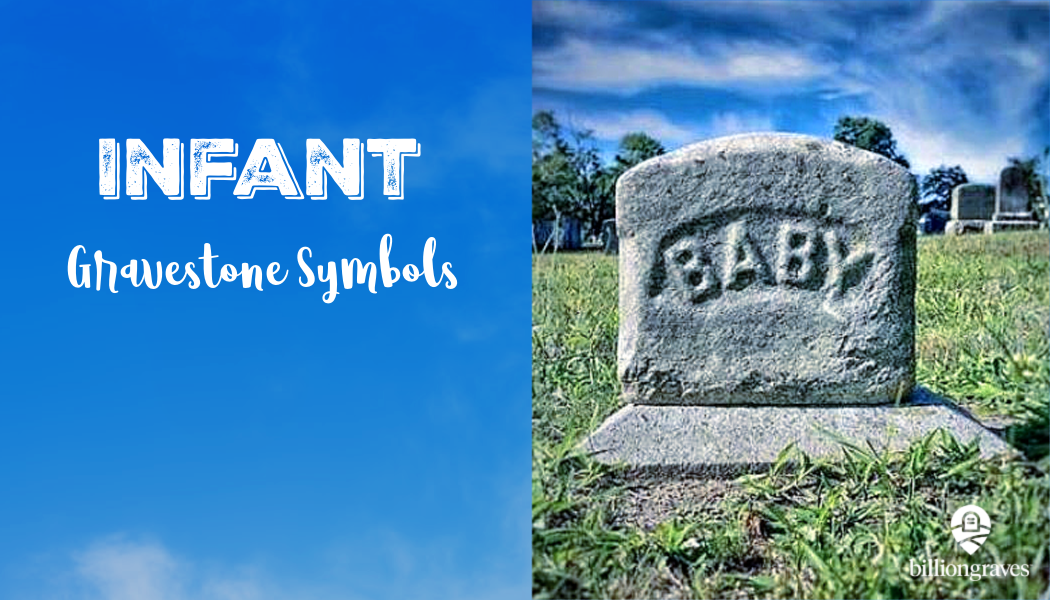Infant gravestone symbols can reveal the beliefs and emotions of our ancestors who lost little ones. An understanding of these symbols can give us a peek into their hearts.
Infant mortality rates were much higher a few generations ago. As we build our family trees, it is very common to see that many of our own ancestor’s children died in infancy.

In 1800, the global average infant mortality rate was 43.3%. To put that into perspective, the rate today is about 3.4%.
By 1880, nearly 22% of children born in the United States died before they reached their first birthday. Ten years later, that rate was down to 15%.
By 1900, there were still more than 10% of infants dying before the age of one, not including stillbirths.

Thus, in older cemeteries, we frequently see gravestones for babies. Sometimes there are entire sections of the cemetery set aside for infants, called “babyland”.
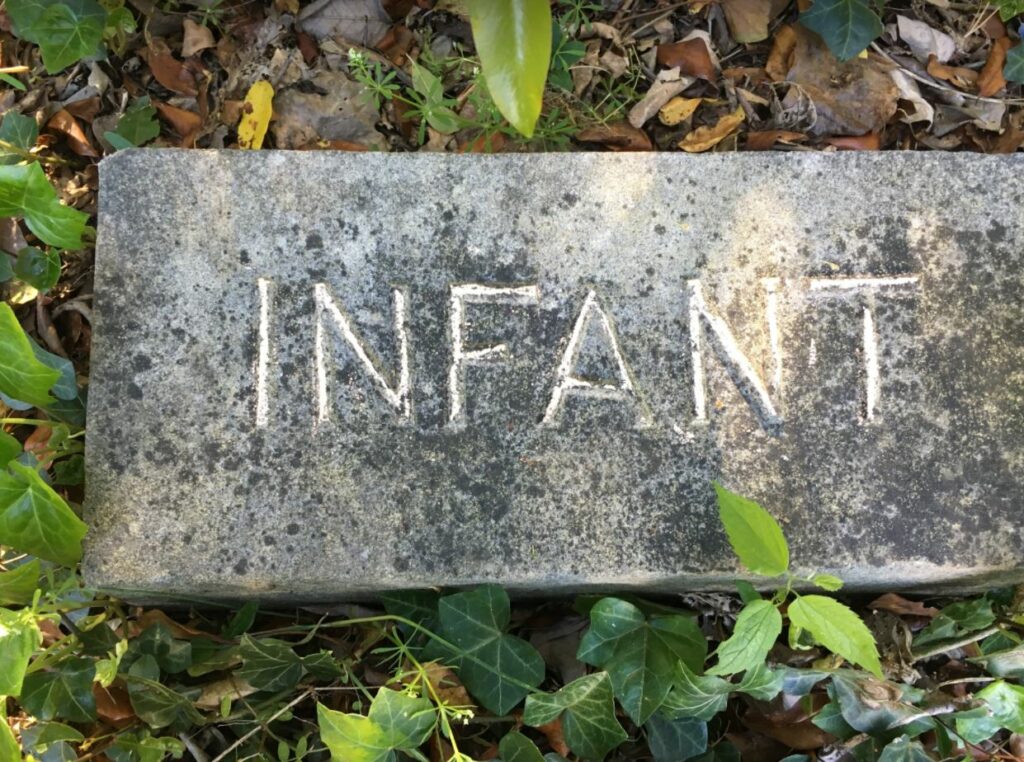
Often, the gravestones for infants are simple – just a name and a date. Sometimes the child wasn’t even given a name and the gravestone simply says “infant” or “baby”.
Other times, the tombstones are very special with symbols that help to heal the brokenhearted parents.
Little Lambs
Lambs are the most common symbol on infants’ gravestones. They are usually lying down and are often asleep.

In the book of John in the New Testament, it is recorded that Jesus asked his apostle Peter three times if he loved Him. Each time, Peter affirmed that he did. And Jesus replied, “Feed my lambs.”

A lamb on a gravestone can be a Christian symbol of one who follows the Good Shepherd.
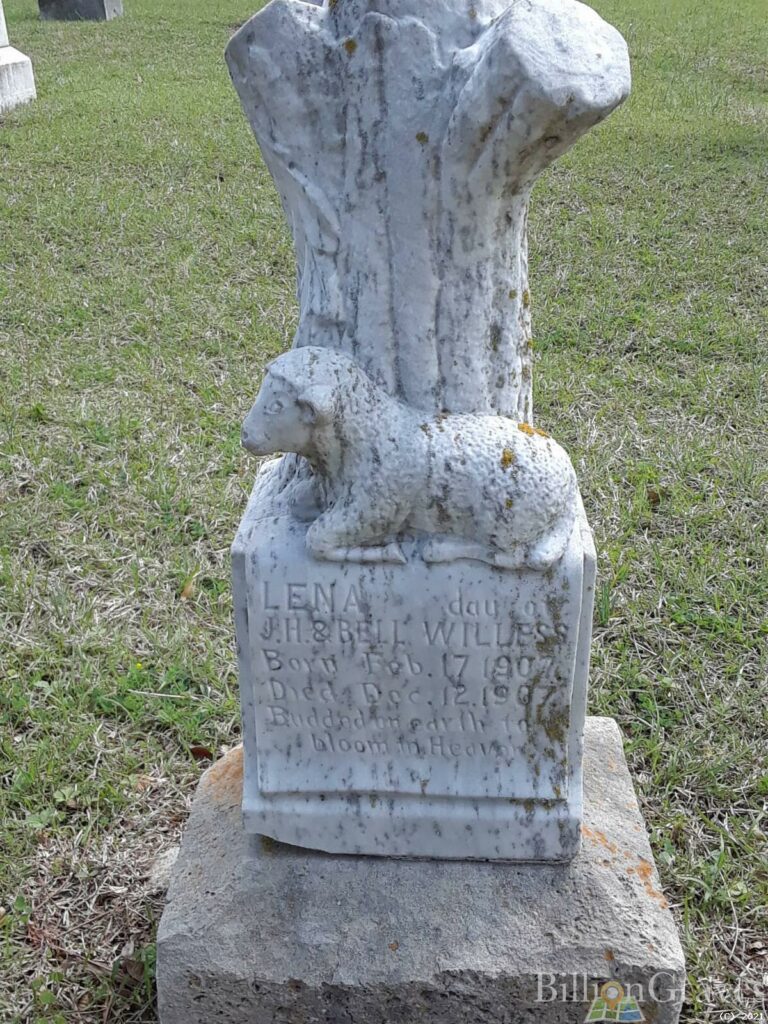
Sheep are instinctive followers. When one sheep decides to go someplace, the rest of the flock usually tags along behind them – even if it is not a good choice. If one sheep runs off a cliff, the other sheep in the flock may follow.
Likewise, small children are naturally submissive and loyal to those who lead them.

This gravestone has a cross and a crown of thorns – symbols of Christ – along with the lamb.
To Christians, lambs are also a symbol of Christ, “Behold the lamb of God, which taketh away the sin of the world” (Holy Bible, John 1:29).
Cradle

This symbol needs little explanation. The cradle is empty. The baby has passed on.
It is so sad that it happened but also so sweet that the family wants to always remember their little one.

Oh, baby! This lifelike cradle and infant are made of stone and rest at the Cemiterio Municipal De Colina in Aracruz, Brazil in remembrance of a very loved little one who will not be forgotten.
The symbolism is simple – “baby is only sleeping”. She will wake in the morning. Resurrection morning.
Lily of the Valley
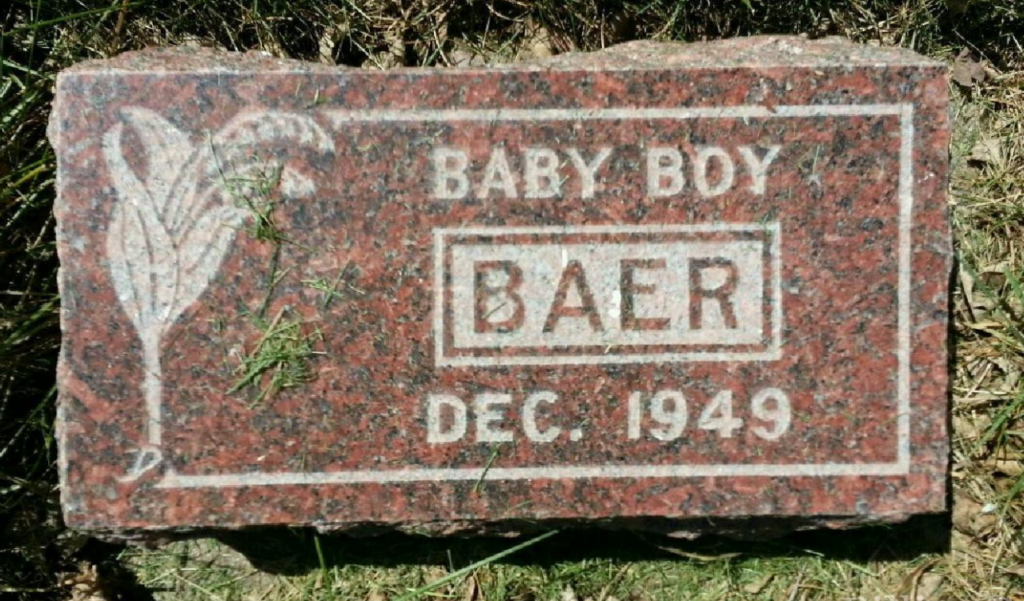
Lily of the valley is a symbol of innocence and purity.
Other types of lilies have the same meaning of innocence and purity but lily of the valley have tiny blossoms. That makes them a sweet remembrance for little ones.
Cross
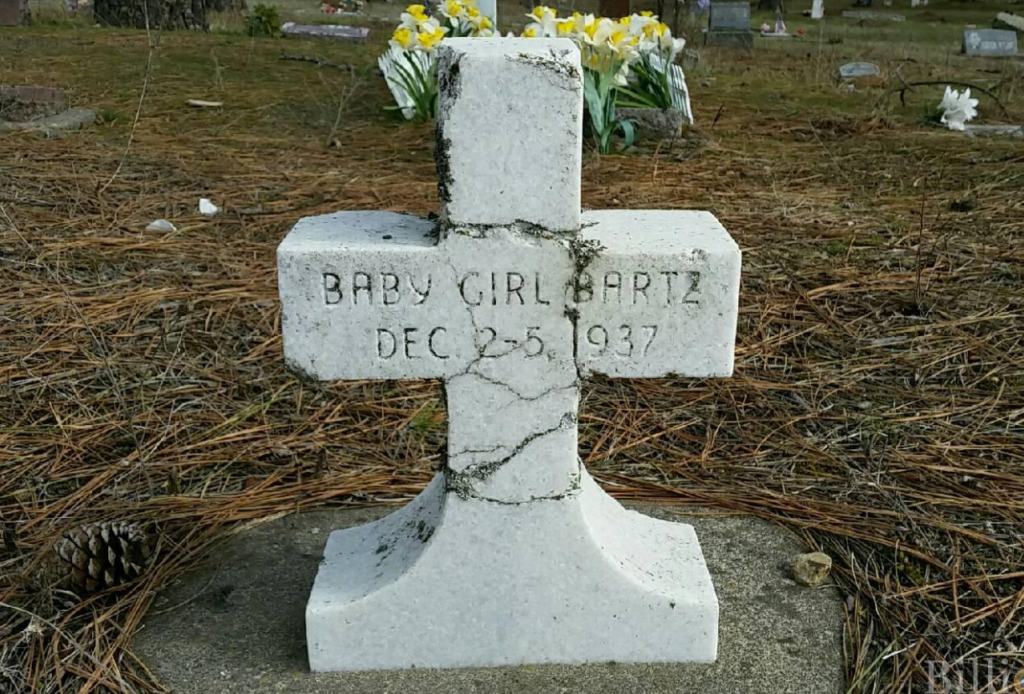
Sadly, this baby girl lived just 3 days. The cross is a symbol of Jesus Christ. It is also a reminder of the hope of resurrection because of His sacrifice.
Click HERE to learn more about cemetery crosses in BillionGraves’ most popular blog post.
Crown and Palm Fronds

The infant gravestone symbols on this tomb are a crown and palm fronds.
Palm trees have been considered sacred in many regions of the world and in many religions. Below are a few examples.
- Egypt – palm branches represent immortality
- Judaism – the lulav, a date palm frond, is used in the Sukkot Festival or Feast of the Tabernacles, a thanksgiving celebration of the harvest
- Ancient Greece – a palm frond was awarded to victorious athletes
- Assyria – the palm tree is considered to be a sacred connection to heaven since its branches reach to skies and its roots are anchored in the earth
- Rome and Phonecia – palm trees appear on ancient coins
- Islam – palm trees are a symbol of rest and hospitality
To Christians, palm branches are associated with Jesus’ triumphal final entry into Jerusalem. In the Bible, it says that the people, “took branches of palm trees, and went forth to meet him, and cried, ‘Hosanna, blessed is the King of Israel that cometh in the name of the Lord’” (John 12:13).
Thus, to Christians, palm fronds came to represent the victory of the spirit over the flesh.
The crown typically symbolizes Christ, also known as the King of Kings.
Tree and Bud

Plant buds on a gravestone symbolize a life not yet in full bloom. They are most often seen on graves of babies, children, or young adults.

Grieving Mother

This gravestone is for an entire family including an infant that was born and died in 1924. Nonetheless, it has many infant gravestone symbols on it, the largest of which is the grieving mother. (No explanation needed! Losing an infant would be heartbreaking.) She is holding roses, a symbol of love.

Again, the crown typically symbolizes Christ, also known as the King of Kings.
A crown with a cross in the center is symbolic of the departed soul gaining victory over death through Christ the King.
Anchor
On this same gravestone with the grieving mother, there is also an anchor.

Sometimes an anchor was carved on the gravestones of seamen since it was their last resort in a storm. But more often, the anchor on a gravestone was a symbol of hope.
The Bible references an anchor in connection with hope in Hebrews 6: 18-19:
“. . . lay hold upon the hope set before us: which hope we have as an anchor of the soul, both sure and steadfast . . .”
Those without hope may be like a ship tossed on the sea, their emotions being carried in every direction.
The anchor would remind family members visiting the grave to hold on to the hope of seeing their loved one again.
Sleeping Angel
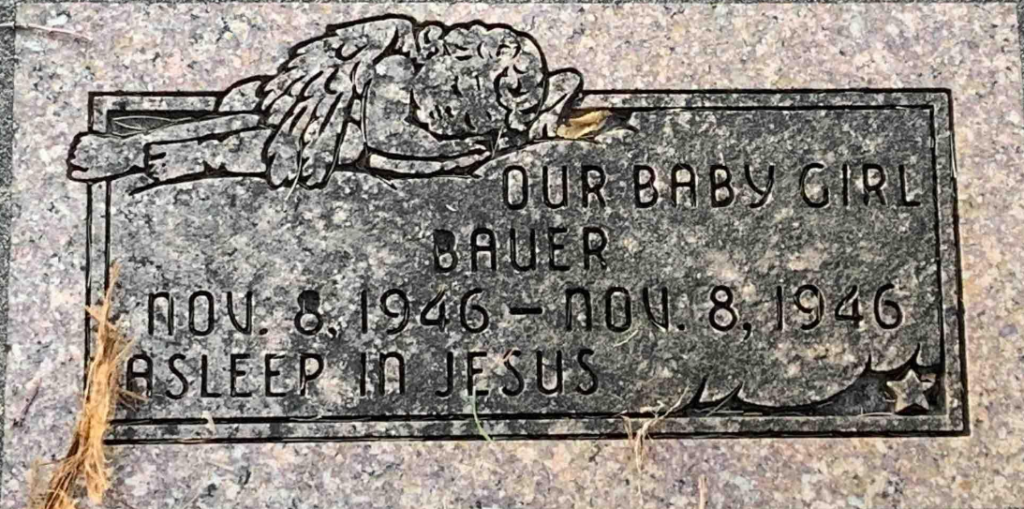
Little angels are symbols of innocence and are often seen on children’s gravestones.
The epitaph on this baby girl’s gravestone says, “Asleep in Jesus”. It signifies the family’s belief that the child will wake again when Christ returns to the earth.
Click HERE to learn more about angels at the cemetery.
Flying Angel

Given the high infant mortality rate in the 1800s, it was a comfort to families to have an image of a flying angel with a baby in its arms on their little one’s gravestone.
This is a symbol of the child being taken to heaven. The angel points heavenward as her feet soar above the clouds.

Although this angel has her feet on the ground, rather than over the clouds, she is ready to take flight with the baby wrapped in a long blanket.
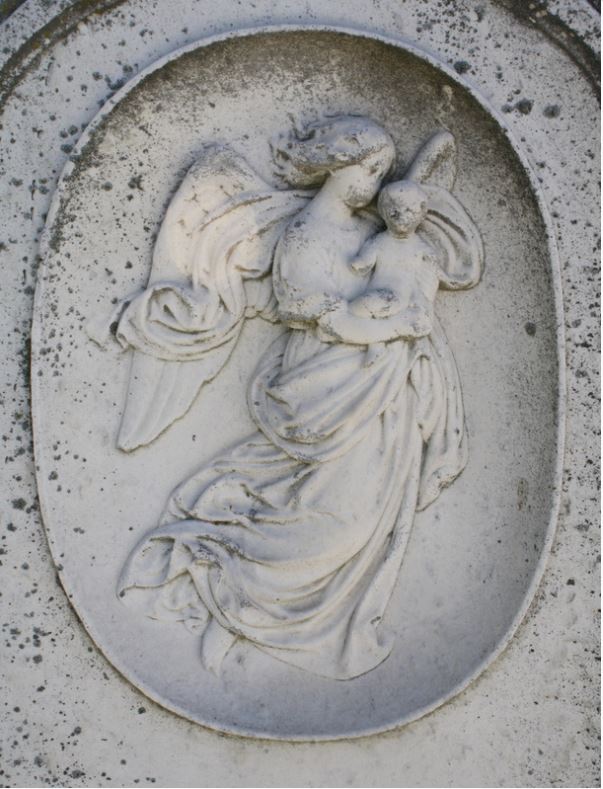
The gravestone symbol of angels flying off with infants is a very old one.

Gravestone carvings were often patterned after published art and illustration themes.
This is a print from an engraving created in 1764 by Francesco Bartolozzi. It uses imagery to show that the angel has come for these little ones in the night. A man sleeps on the haystack and cattle rest in the field. The sky has stars, bats, and an owl. Even the babies themselves continue to sleep as they are carried off to heaven by the angel.
Click HERE to see another flying angel gravestone on BillionGraves website.
Bird

Birds in flight are sometimes seen on adult gravestones but are more often symbols on children’s gravestones. They represent a soul that has left its body.
Dove

The dove in flight is a cemetery symbol of the Holy Spirit.
This comes from the New Testament references to Jesus Christ’s baptism by John the Baptist, “And straightway coming up out of the water, he saw the heavens opened, and the Spirit like a dove descending upon him.” (Mark 1:10)

Doves are a symbol of purity and innocence.
It was a dove that brought an olive branch to Noah on the ark after the rains stopped. So doves also represent hope.
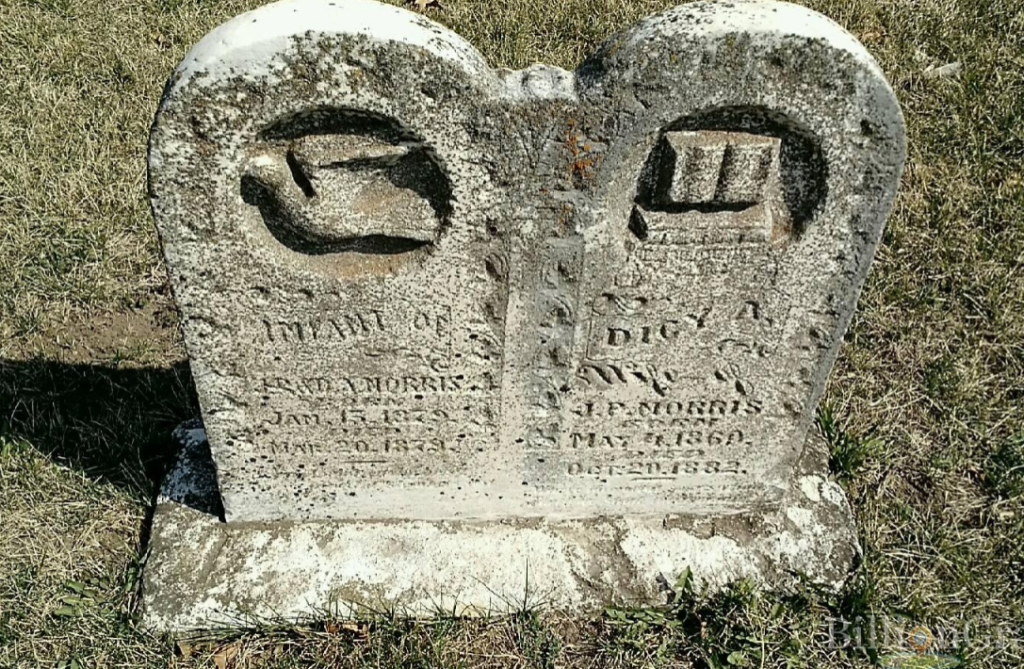
This double gravestone is for a mother and her baby. The infant’s side has a flying dove and the mother’s side has books.
A book on a gravestone can symbolize the good deeds of the departed, as recorded in the book of life. It can also represent the scriptures, as a sign of faith.
Books may also indicate that a scholar or teacher is buried at the gravesite. An open book can signify an early death for someone whose life story was not yet fully written.
Birds and Chalice

This is a double gravestone in Texas for an infant boy that lived from 25 December 1881 to 7 January 1882 and his brother Paul who lived just over a year: 3 July 1880 – 1 August 1881.
The symbol at the top is a pair of birds drinking from a chalice. A chalice is a large cup or goblet, typically used for drinking wine in the Christian Eucharist. It is done in remembrance of Christ’s last supper.
The birds and the chalice on this gravestone represent these two little boys receiving the blessings of the atonement.
Drooping Flower
Flowers are a common symbol on gravestones.

A full-blown or half-opened rose drooping from a broken stem indicates a life that ended earlier than expected.
Evergreen Boughs

Since pine trees stay green all year long, rather than losing their leaves in the fall, they are symbols of immortality and everlasting life.
Ivy

There is ivy engraved on this headstone which, being another evergreen plant, represents eternity. It is also a clinging vine so is signifies fidelity and a strong affectionate attachment to the deceased.
The epitaph at the bottom of this gravestone says “only sleeping”. It assures cemetery visitors that the infant babies resting there will wake again when they are resurrected.
The Hand of God and a Rose
There are some gravestones that bring tears to my eyes and this is one of them.

It features the hand of God reaching down to pluck a blooming rose. You can see where the stem has been snapped off and the roots pulled from the dirt.
The rose was a Victorian era symbol for love. Even today, we give a single red rose to say, “I love you.”
This gravestone is telling us that the parents recognized the hand of God in taking their beloved infant out of the garden of life for a time. There are green leaves which symbolize life and a hope for regrowth. It means that they trust in God with a hope for the resurrection of their child.
Sleeping in a Seashell
From 1870 to 1920, a fairly common infant gravestone symbol was a baby sleeping in a seashell.

We can only guess how this symbol got its start since the tale is lost to history.
Some say the sea shell is a symbol of St. James because he is said to have been washed up from the ocean on the shores of northern Spain. Others say the symbol was adapted from popular children’s books of the time about babies and seashells.

Vintage baby bassinets and strollers often had shell-like forms, especially those made of wicker which bent easily into scalloped shapes.
The carriage hood curved up over the child to provide protection from the weather. Passing admirers peeked beneath the pram’s hood to see the baby sleeping there.

It may have been the baby’s carriage that inspired the seashell-shaped gravestone monuments. Like the pram, cemetery visitors would peek beneath the seashell hood to see the baby “only sleeping” inside.
Either way, both the pram and the monument revealed the desire for the family to display their most precious treasure in a way that conveyed how much they cherished their baby.

The baby on this stylized shell tombstone is more “doll-like” than “baby-like”. She is even wearing a bonnet and shoes.

The little one was being displayed like a pearl in an oyster.

At first, the monuments of babies sleeping in their seashells were hand-carved. But in time, the symbol became so popular that they were mass-produced and marketed in Sears and Robuck catalogs. At that point, it is likely that the symbol meant different things to different people.
____
Family Plot
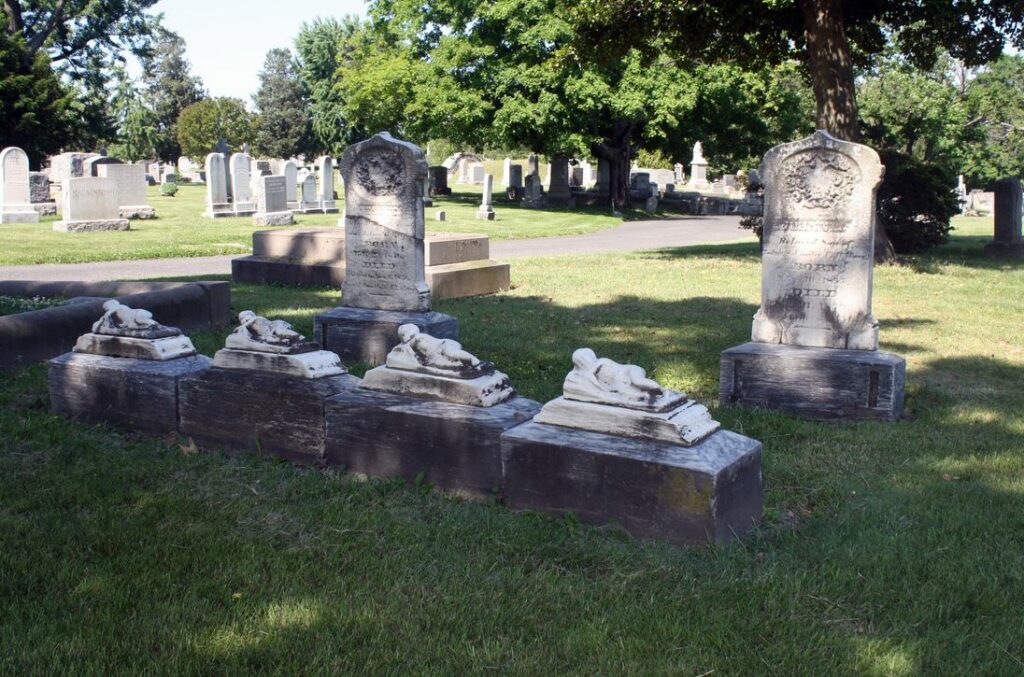
Sadly, this family lost multiple infants. Four sleeping baby statues rest in front of their parent’s gravestones.
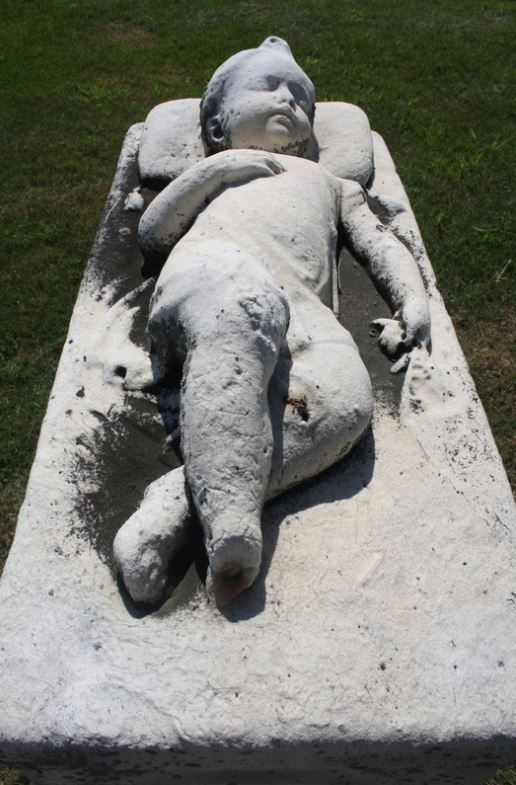
Just sleeping . . .
Unmarked Graves
Babies were often buried in unmarked graves without a marker.

To learn how you can document an unmarked grave with the BillionGraves app, click HERE.
Learn More
To learn more about gravestone symbols, click HERE.

Volunteers Wanted!
We need your help to take gravestone photos with the BillionGraves app! Click HERE to get started.
You are welcome to do this at your own convenience, no permission from us is needed. If you still have questions after you have clicked on the link to get started you can email us at Volunteer@BillionGraves.com.
Happy Cemetery Hopping!
Cathy Wallace

